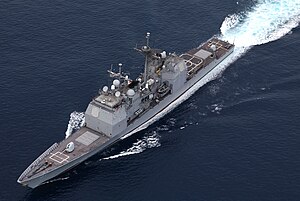Aegis Combat System

The Aegis combat system is an integrated weapons system used by the United States Navy. It is both an integrated single ship system and a ship-to-ship network. The Aegis combat system is one of the most advanced and most capable defense systems currently in use. It is also used by the Japan Maritime Self-Defense Force, Spanish Navy, Royal Norwegian Navy, and Republic of Korea Navy. The Royal Australian Navy has selected the Aegis system for placement on their new destroyers. A total of 108 Aegis-equipped ships have been deployed in five navies worldwide.
Aegis was initially developed by the Missile and Surface Radar Division of RCA, which was then acquired by General Electric. The division responsible for the Aegis systems became Government Electronic Systems. This, and other GE Aerospace businesses, were sold to Martin Marietta in 1992.[1] This became part of Lockheed Martin in 1995.
Overview

The Aegis weapon system is an advanced combat, control, and information system that uses powerful computers and radars to track and destroy enemy targets. It is the most advanced modern combat system and is the first fully integrated combat system built to defend against air, surface, and subsurface threats.
The Aegis Weapons System comprises the SPY-1 Radar, MK 99 Fire Control System and ORTS, MK 41 VLS, the Command and Decision Suite, and SM-3 Standard Missile systems. Shipboard torpedo and naval gunnery systems are also integrated.[2] The Aegis combat system is controlled by an advanced, automatic detect-and-track, multi-function three-dimensional passive electronically scanned array radar, the AN/SPY-1. Known as "the Shield of the Fleet", the SPY high-powered (four megawatt) radar is able to perform search, tracking, and missile guidance functions simultaneously with a track capacity of well over 100 targets at more than 100 nautical miles (190 km).[3]
The Aegis system uses missile uplink using the AN/SPY-1 radar for midcourse guidance of Standard missiles during engagements, but still requires the AN/SPG-62 radar for terminal guidance. This means that with proper scheduling of intercepts, a large number of targets can be engaged simultaneously.
The computer-based command-and-decision element is the core of the Aegis combat system. This interface makes the Aegis combat system capable of simultaneous operation against almost all kinds of threats. The Aegis system is being enhanced to act in a Theater Missile Defense role, to counter short- and medium-range ballistic missiles of the variety typically employed by rogue states (see Aegis Ballistic Missile Defense System).
Development

By the late 1950s, the US Navy replaced guns with guided missiles on its ships. These were sufficient weapons but by the late 1960s, the U.S. Navy recognized that reaction time, firepower, and operational availability in all environments did not match the anti-ship missile threat.
As a result, the US Navy decided to develop a program to defend ships from anti-ship missile threats. An Advanced Surface Missile System (ASMS) was promulgated and an engineering development program was initiated to meet the requirements. ASMS was re-named "Aegis" in December 1969 after the aegis, the shield of the Greek god Zeus. The name was coined at the suggestion of Captain L. J. Stecher, a former Tartar Weapon System manager, after an internal U.S. Navy contest to name the ASMS program was initiated. Captain Stecher also submitted a possible acronym of Advanced Electronic Guided Interceptor System although this definition was never used.[4] While many other meanings have been attributed to the name Aegis, the name is not an acronym. The main manufacturer of the Aegis combat system, Lockheed Martin, makes no mention of it being an acronym, nor does the U.S. Navy.

The first Engineering Development Model (EDM-1) was installed in a test ship, the USS Norton Sound, in 1973. This was the first fully-operational seaborne phased-array RADAR. The Navy built the first Aegis-equipped cruisers using the hull and machinery designs of Spruance-class destroyers. The first cruiser of this class was the Ticonderoga, which uses two twin-armed Mark-26 missile launchers, fore and aft. The commissioning of the sixth ship of the class, the Bunker Hill opened a new era in surface warfare as the first Aegis ship outfitted with the Martin Marietta Mark-41 Vertical Launching System (VLS), allowing a wider missile selection, more firepower, and survivability. The improved AN/SPY-1B radar went to sea in the Princeton, ushering in another advance in Aegis capabilities. The Chosin introduced the AN/UYK-43/44 computers, which provide increased processing capabilities.
In 1980, a destroyer was designed using an improved sea-keeping hull form, reduced infrared, and radar cross-section and upgrades to the Aegis Combat System. The first ship of the Arleigh Burke class, the USS Arleigh Burke, was commissioned in 1991. Because the Aegis system dominates the ship's architecture, ships equipped with it are sometimes mistakenly called Aegis class ships.
Flight II of the Arleigh Burke class, introduced in 1992, incorporated improvements to the SPY radar, and to the Standard missile, active electronic countermeasures, and communications. Flight IIA, introduced in 2000, added a helicopter hangar with one anti-submarine helicopter and one armed attack helicopter. The Aegis program has also projected reducing the cost of each Flight IIA ship by at least $30 million.
Capabilities
The Aegis combat system is the most capable surface launched missile system currently being used.[5] It can guide weapons to destroy almost any kind of threat including attacks from subsurface, surface, and the air. Because of its advanced computer system, the Aegis combat system can track over 100 weapons. Some Aegis equipped ships can track even more targets at one time.
Iran Air Flight 655

The Aegis system was involved in an incident in which USS Vincennes shot down Iran Air Flight 655 in 1988 resulting in 290 civilian fatalities.
It was determined by a formal military investigation[6] that the Aegis system was fully operational and did not have any maintenance issues. The investigation ruled that had the Commanding officer relied on the full tactical data displayed by the Aegis system, (i.e. Doctrine), the engagement might never have occurred. Additionally, psychological effects of the crew subconsciously manipulating the data to fit a predefined scenario greatly contributed to the false identification. The investigation found that the Aegis Combat System did not contribute to the incident, but did aid in the investigation by means of recorded target data. The discrepancies are as follows:
| Aegis Data Report | Personnel Report To CO |
|---|---|
| Iran Air Flight 655 continuously ascended in duration of flight | Iran Air Flight 655, after attaining 9000 to 12,000 ft (3,700 m)., reportedly descended on an attack vector on USS Vincennes |
| Iran Air Flight 655 continuously squawked Mode III (Civilian Airliner) IFF in duration of flight | Iran Air Flight 655 reportedly squawked Mode II (Iranian F-14 Tomcat) IFF momentarily, personnel proceeded to label the target from "Unknown Assumed Enemy" to "F-14" |
| Iran Air Flight 655 held consistent climb speed in duration of flight | Iran Air Flight 655 was reported to increase in speed to an attack vector similar to an F-14 Tomcat |
Aegis in other navies

| Ship Class | Operator | Total Ships |
|---|---|---|
| Atago | 2 | |
| Kongō | 4 | |
| King Sejong the Great | 1 | |
| Fridtjof Nansen | 5 | |
| Álvaro de Bazán | 5 | |
| Arleigh Burke | 64 | |
| Ticonderoga | 27 | |
| Total | 110 | |
- Australia, under its Sea 4000 project to acquire three air warfare destroyers, decided in August 2004 that Aegis would be the core of the combat system for the Royal Australian Navy ships. On 20 June 2007, the Australian government announced it had selected the Navantia F-100 Álvaro de Bazán class design over a variant of the Arleigh Burke design. The Australian variant will be known as the Hobart class.
- Japan operates four Kongō-class destroyers of a modified Arleigh Burke design from 1993. Two improved units known as the Atago class were purchased in 2000 and the first ship of this class, DDG 177 Atago, was commissioned March 15, 2007.
- Norway is procuring five ships of Spanish manufacture which include a U.S. sourced Aegis system integrated onto the ships, as the Fridtjof Nansen class. The first unit of this type, Fridtjof Nansen, was launched on June 3, 2004. The second of five Norwegian Nansen class frigates, the Roald Amundsen, completed its sea trials and entered service in June 2007. The 5,200 ton Nansen class ships are being built in Spain and cost $600 million each.
- Republic of Korea is building Aegis variants of its KDX destroyers, called KDX-III. The first ship of the class, King Sejong the Great, was launched on May 25, 2007.
- Spain is currently operating five Álvaro de Bazán class Aegis frigates, with at least four in commission.
References
- ^ Lenorovitz, Jeffrey. "GE Aerospace to merge into Martin Marietta" Aviation Week & Space Technology. 1992-11-30. Accessed on 2007-07-19
- ^ Originally, the first five ships of the United States' Aegis equipped Ticonderoga class cruisers were outfitted with Mark-26 twin-arm missile launchers; however, the ships with this system have been decommissioned and are no longer in service.
- ^ "Aegis Combat System". The Warfighter Encyclopedia. Warfighter Response Center. 2003-10-08. Retrieved 2006-08-10.
{{cite web}}: Cite has empty unknown parameter:|coauthors=(help); External link in|authorlink= - ^ Lockheed Martin. "Aegis Heritage". Presentation. November 20, 2002.
- ^ [1]
- ^ Fogarty, William M. (July 28 1988), Formal Investigation into the Circumstances Surrounding the Downing of Iran Air Flight 655 on 3 July 1988, 93-FOI-0184, retrieved 2006-03-31
{{citation}}: Check date values in:|year=(help)CS1 maint: year (link)
See also
External links
- AEGIS Weapon System MK-7 in the FAS Military Analysis Network.
- DDG-51 ARLEIGH BURKE-class in the FAS Military Analysis Network.
- "AN/SPY-1". The Warfighter Encyclopedia. Warfighter Response Center. 2003-10-08. Retrieved 2006-08-10.
{{cite web}}: Cite has empty unknown parameter:|coauthors=(help); External link in|authorlink=
- "AEGIS Weapon System MK-7". Jane's Information Group. 2001-4-25. Retrieved 2006-08-10.
{{cite web}}: Check date values in:|date=(help); Cite has empty unknown parameter:|coauthors=(help); External link in|authorlink=
- "MK 7 AEGIS FIRE CONTROL SYSTEM RADAR". FIRE CONTROLMAN, VOLUME 02--FIRE CONTROL RADAR FUNDAMENTALS (PDF). US NAVY. Retrieved 2006-08-10.
{{cite book}}: Cite has empty unknown parameters:|1=and|2=(help); External link in|chapterurl=|chapterurl=ignored (|chapter-url=suggested) (help).

